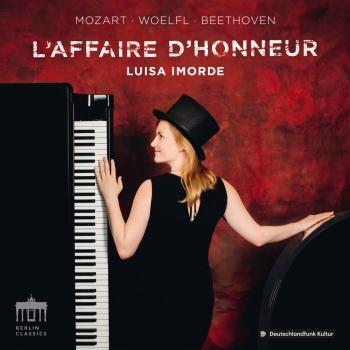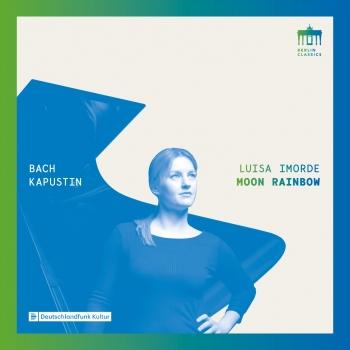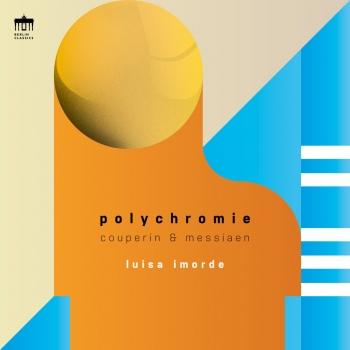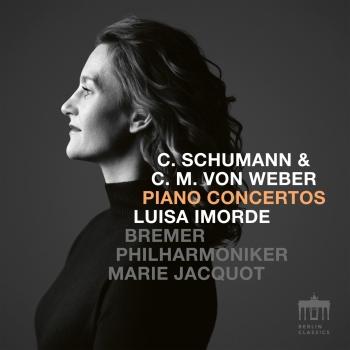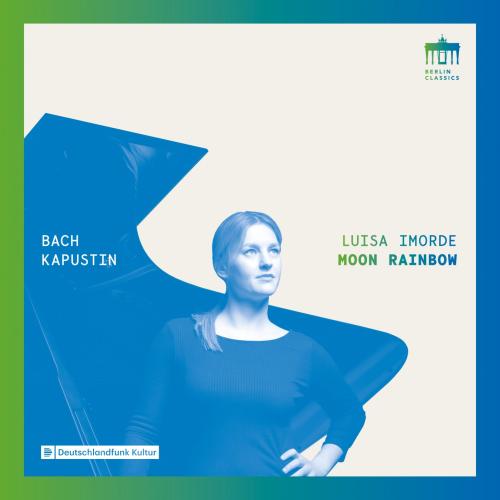
Bach & Kapustin: Moon Rainbow Luisa Imorde
Album info
Album-Release:
2020
HRA-Release:
06.03.2020
Label: Berlin Classics
Genre: Classical
Subgenre: Instrumental
Artist: Luisa Imorde
Composer: Nikolai Kapustin (1937), Johann Sebastian Bach (1685-1750)
Album including Album cover
- Johann Sebastian Bach (1685 - 1750):
- 1 Concerto in D Minor, BWV 974 after Marcello: I. Andante 02:44
- Nikolai Kapustin (b. 1937):
- 2 24 Jazz Preludes, Op. 53: IV. Allegretto 01:30
- Johann Sebastian Bach:
- 3 Concerto in D Minor, BWV 974 after Marcello: II. Adagio 03:29
- Nikolai Kapustin:
- 4 24 Jazz Preludes, Op. 53: V. Largo 02:06
- Johann Sebastian Bach:
- 5 Concerto in D Minor, BWV 974 after Marcello: III. Presto 04:15
- Nikolai Kapustin:
- 6 8 Concert Studies, Op. 40: VI. Pastoral. Allegro moderato 02:38
- Johann Sebastian Bach:
- 7 Pastorale in F Major, BWV 590: III. Andante cantabile (Arr. for Piano) 03:30
- Nikolai Kapustin:
- 8 8 Concert Studies, Op. 40: III. Toccatina. Allegro 02:21
- Johann Sebastian Bach:
- 9 Toccata in E Minor, BWV 914 08:09
- Nikolai Kapustin:
- 10 24 Jazz Preludes, Op. 53: IX. Lento 03:10
- Johann Sebastian Bach:
- 11 Prelude and Fugue in C-Sharp Major, BWV 872 03:44
- Nikolai Kapustin:
- 12 24 Preludes and Fugues in B-Flat Minor, Op. 82: XXII. Allegretto. Grave 03:16
- Johann Sebastian Bach:
- 13 Prelude and Fugue in B Major, BWV 892 05:32
- Nikolai Kapustin:
- 14 10 Inventions, Op. 73: IX. Lento 03:02
- Johann Sebastian Bach:
- 15 Invention No. 6 in E Major, BWV 777 04:10
- Nikolai Kapustin:
- 16 Sonatina, Op. 100 03:56
- Johann Sebastian Bach:
- 17 Concerto in D Major, BWV 972 after Vivaldi: I. Allegro 02:02
- Nikolai Kapustin:
- 18 Moon Rainbow, Op. 161 05:47
- Johann Sebastian Bach:
- 19 Concerto in D Major, BWV 972 after Vivaldi: II. Larghetto 02:47
- Nikolai Kapustin:
- 20 Contemplation, Op. 47 06:21
- Johann Sebastian Bach:
- 21 Concerto in D Major, BWV 972 after Vivaldi: III. Allegro 02:27
- Nikolai Kapustin:
- 22 24 Jazz Preludes, Op. 53: XXIII. Moderato 02:24
Info for Bach & Kapustin: Moon Rainbow
Pianist Luisa Imorde loves innovative combinations: following on from circus dances by Schumann and Widmann and the affair of honour between Woelfl and Beethoven, she now prepares to cast light on Johann Sebastian Bach and Nikolai Kapustin. This is an album whose spectrum ranges from Baroque counterpoint through to polyrhythmic jazz sounds.
They could hardly be further apart: Bach and Kapustin lived 250 years apart and on two different continents. One is the indisputable supremo of European classical music, the other a Ukrainian composer known only to a few aficionados in central Europe, someone who transforms musical jazz sequences into formal, classical structures. On Moon Rainbow they alternate. “There is no established listening convention for this. The result is a foundation of literally unheard sounds, which makes it possible to hear anew – so to speak – a familiar old piece by Bach in this new context,” explains Imorde. Nikolai Kapustin is hardly a household name, even in Europe. Born in 1937 in Horlivka in what was then the Ukrainian Soviet Socialist Republic, the composer and pianist began pouring improvisatory ideas into forms that were well known in the Baroque era. What he wrote sounded like virtuoso jazz, yet every single note, every accent and all the dynamics are clearly defined. Preludes, Fugues, Inventions – even at this level, everything ultimately leads to Bach. And what Luisa Imorde says of Kapustin can also be related to Bach: “I can’t remember when I played music that was more intelligently and humorously constructed. It is incredibly interlocked and so rhythmically multi-layered that I sometimes feel as if I need to split my head from my hands in order to follow every line, every voice.”
“I really like it when I can properly immerse myself in a topic.” Before making these recordings, Imorde was able to view Kapustin’s own manuscripts at his publisher, Schott. “I really get a kick out of that – and at the same time, it allows me to offer my listeners something they have never heard before.” So it was that she decided on the piece that would lend its name to the album: Moon Rainbow. She is the first pianist to ever record it. “In comparison to the other compositions by Kapustin, Moon Rainbow is very varied. The piece develops a very rich fabric of tonal colours. That too is why the title is so perfect for the work.” It did not take long for her to decide that the album itself should take that title; she figures that just as Kapustin is barely known, most people have no idea of the existence of moon rainbows, yet both are worth discovering. She wishes to encourage listeners to read between the lines: “When a piece by Bach dies away and a work by Kapustin begins, there is a magical moment, because just in that short space of time it’s not clear where the music will go next.”
Luisa Imorde, piano
Luisa Imorde
couples a mature playing technique with an unbridled passion for the piece she is playing and the instrument she is playing it on, resulting in an auditory experience that kindles the spirit and sets the heart aflame" – said the Süddeutsche Zeitung of the young German pianist’s art.
She no longer knows exactly when she started playing the piano. Actually she cannot remember a time when she did not play the piano. Luisa Imorde comes from a family of musicians. She was a very small girl when she took her first piano lessons from her mother, who was already an experienced educator. Her father currently occupies a position as professor for piano at the University of Music in Rostock.
The young artist commenced her studies with Andreas Frölich at the University of Music in Cologne in the last two years before her school leaving examination. She continued them at the Salzburg Mozarteum with Jacques Rouvier, who is considered one of the world’s most important teachers of the piano. Luisa Imorde has played at competitions and won prizes, but she finds it much more interesting to compare and contrast the works of various composers with the declared aim of making us – her audience – listen to them in a new way and showing us relationships that we had never noticed before.
This album contains no booklet.









